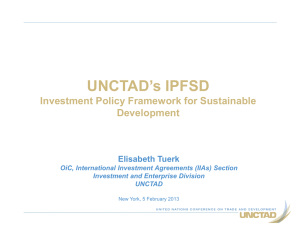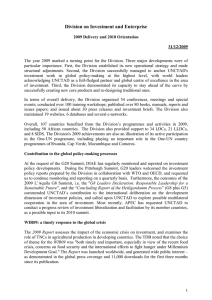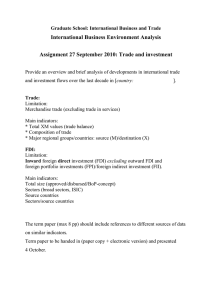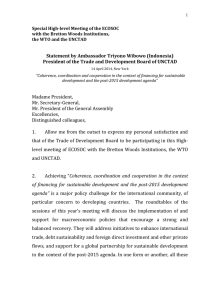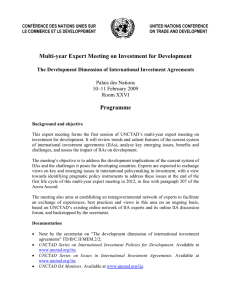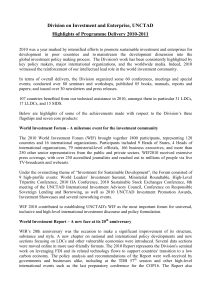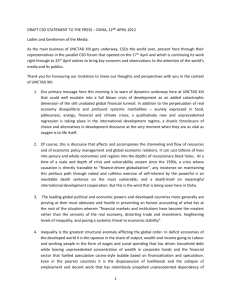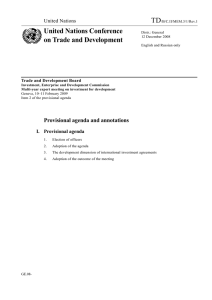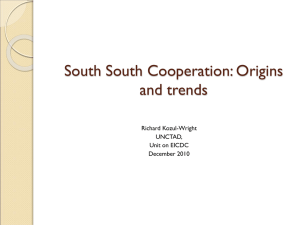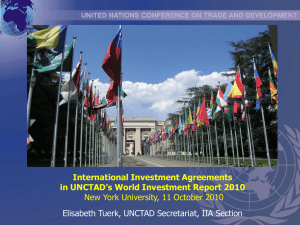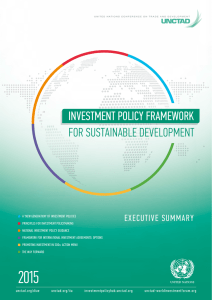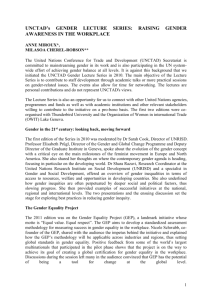UNCTAD`s IPFSD: Why now?
advertisement
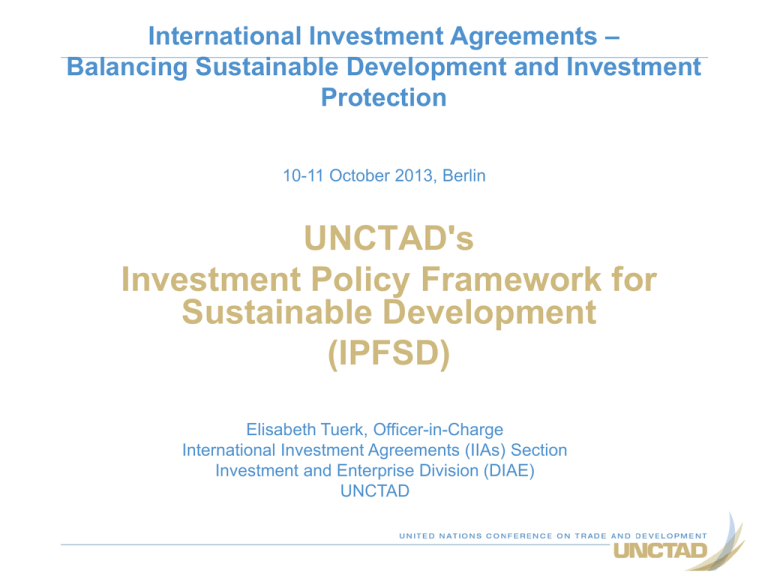
International Investment Agreements – Balancing Sustainable Development and Investment Protection 10-11 October 2013, Berlin UNCTAD's Investment Policy Framework for Sustainable Development (IPFSD) Elisabeth Tuerk, Officer-in-Charge International Investment Agreements (IIAs) Section Investment and Enterprise Division (DIAE) UNCTAD UNCTAD’s IPFSD: Why now? 1. Evolving global investment landscape for a new investment-development paradigm/path 2. Imperative for mainstreaming sustainable development into the investment policy core 3. Investment policy making at a crossroads: at times of reflection, review and revision 4. Challenges of systemic flaws, issues of policy coherence, synergy and effectiveness Need guidelines and tools Foreign direct investment is the largest source of development finance FDI, remittances and ODA to developing economies, 2000-2012 (Billions of dollars) Developing economies surpass developed economies as FDI recipients for the first time FDI inflows by group of economies, 1995 – 2012 (Billions of dollars) 2 500 World total 2 000 Developed economies 1 500 Transition economies 1 000 Developing economies 42% 500 52% 0 1995 1996 1997 1998 1999 2000 2001 2002 2003 2004 4 2005 2006 2007 2008 2009 2010 2011 2012 Imperative for mainstreaming sustainable development into the investment policy core Investment policy making at a crossroads: Most countries remain keen to attract FDI while becoming more selective and reinforcing regulatory frameworks Changes in national investment policies, 2000 – 2012 (Per cent) 100 94% 75 Liberalization/promotion 75% 50 Restriction/regulation 25% 25 6% 0 12 Investment policy making at a crossroads: The number of newly signed IIAs continues to decline Trends in IIAs, 1983–2012 The current three-year average of one new IIA per week is considerably lower than the 4 new IIAs per week average of the mid-1990s. A record number of 58 new ISDS cases were initiated in 2012 Known ISDS cases, 1987-2012 58 new ISDS claims in 2012 - the highest number for a single year. Total number of known cases at the end of 2012: 514. UNCTAD’s IPFSD: Why now? 1. Evolving global investment landscape for a new investment-development paradigm/path 2. Imperative for mainstreaming sustainable development into the investment policy core 3. Investment policy making at a crossroads: at times of reflection, review and revision 4. Challenges of systemic flaws, issues of policy coherence, synergy and effectiveness Need guidelines and tools UNCTAD's Investment Policy Framework for Sustainable Development (IPFSD) IPFSD: Key characteristics Holistic IPFSD Systemic Synergistic Addressing all dimensions of investment policy IPFSD: Structure & components IPFSD helps policymakers address today’s investment policy challenges IPFSD: Core principles for investment policymaking 1 Investment for sustainable development …overarching objective of investment policymaking … 2 Policy coherence …grounded in a country’s overall development strategy … coherent and synergetic … 3 Public governance and institutions …involving all stakeholders … standards of public governance …predictable, efficient and transparent procedures for investors 4 Dynamic policymaking …regular reviews for effectiveness and relevance … 5 Balanced rights and obligations …setting out rights and obligations of States and investors in the interest of development 6 Right to regulate …in the interest of the public good and to minimize potential negative effects 7 Openness to investment …in line with development strategy … open, stable and predictable entry conditions … 8 Investment protection and treatment …adequate protection to established investors … non-discriminatory 9 Investment promotion and facilitation …aligned with sustainable development goals … minimize risk of harmful competition for investment 10 Corporate governance and responsibility …promote adoption of and compliance with best international practices of CSR … 11 International cooperation …address shared investment-for-development challenges … avoid investment protectionism How national investment policymaking works in the IPFSD The challenges of international investment policymaking International investment policymaking: 3 levels • Formulating a strategic approach to international engagement on investment – Integrating IIAs into a country's development strategy – Understanding what IIAs can and cannot do • Designing sustainable development friendly IIA clauses – What type of agreement (BIT or FTA) – What type of relationship (bilateral or regional) – With whom • Engaging in multilateral consensus building IIA table of elements in the IPFSD: How it works An excerpt from the IPFSD framework Examples of IPFSD policy options • Carefully craft scope and definitions clause. • Structure FET as an exhaustive list of State obligations. • Distinguish legitimate regulations from regulatory takings. • Make full protection and security commensurate with a country’s level of development. • Limit the scope of the transfer of funds clause. • Include exceptions to protect human rights, health, labor standards, and the environment. • Consider, in light of host country’s quality of judicial and administrative system, no ISDS, or last resort ISDS jurisdiction. • Create an institutional setup that makes the IIA adaptable to changing development contexts. IPFSD: What for? End-use Reference for policy making: a "policy at a glance" for politicians, a handbook for national policy makers, and “checklist of options” for treaty negotiators Tool for technical assistance: framework for IPRs, basis for updating regulatory regimes, menu for training, a handbook for general advisory services Basis for consensus-building: • Short-term: promoting common understanding on key issues related to investment for sustainable development; • Longer-term: a stepping stone for formulating common denominators of multilateral cooperation Living framework for all stakeholders to contribute: "open source“ on the web and discussion forum for best practices. IPFSD – What for? End-use and next steps Growing tendency to craft treaties in line with sustainable development objectives By the end of 2013, more than 1,300 BITs will be at the stage where they could be terminated or renegotiated at any time Cumulative number of BITs that can be terminated or renegotiated Treaty expiration provides window of opportunity for improving the IIA regime. Countries need to analyse the pros and cons of treaty termination and its implication for the overall investment climate and existing investments. Source : UNCTAD The Investment Policy Hub and the IPFSD THANK YOU! The Investment Policy Hub: http://investmentpolicyhub.org UNCTAD websites: www.unctad.org/diae www.unctad.org/wir www.unctad.org/fdistatistics @unctadwif
